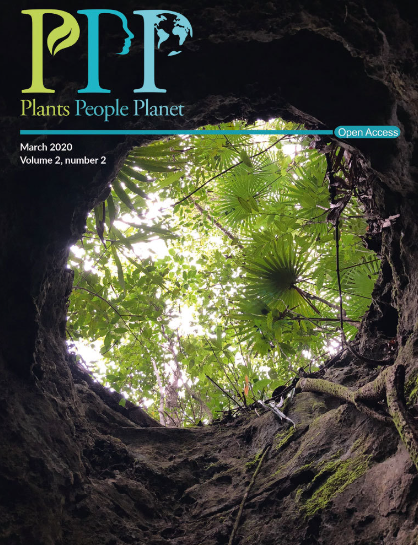Poison ivy (Toxicodendron radicans ) leaf shape variability: Why plant avoidance‐by‐identification recommendations likely do not substantially reduce poison ivy rash incidence
IF 3.6
2区 环境科学与生态学
Q1 BIODIVERSITY CONSERVATION
引用次数: 0
Abstract
Societal Impact Statement Avoidance of poison ivy plants is currently the primary approach to prevent the estimated 30–50 million annual poison ivy skin rash cases. The “leaves of three let it be” mnemonic device lacks specificity to differentiate poison ivy from other three‐leaflet native plants. This report demonstrated that poison ivy leaves show marked total leaf shape variability that likely confounds accurate poison ivy plant identification, and significantly undermines a poison ivy avoidance strategy for mitigating poison ivy rash cases. Therefore, there is an ongoing need to develop prophylactic medical procedures to prevent poison ivy rash that do not depend on human poison ivy plant identification. Summary Urushiol is the natural product produced by poison ivy ( Toxicodendron radicans ) that is responsible for millions of cases of delayed contact allergenic dermatitis in North America each year. Avoidance of poison ivy plant material is the clinically recommended strategy for preventing urushiol‐induced dermatitis symptoms. However, poison ivy leaf shape is anecdotally notoriously variable, thereby confounding accurate poison ivy identification. This study focused on quantitative analyses of poison ivy and a common poison ivy look‐alike (American hog peanut) leaf shape variability in North America to empirically validate the high degree of poison ivy leaf shape plasticity. Poison ivy and American hog peanut iNaturalist.org records were scored for seven attributes of compound leaf shape that were combined to produce a total leaf complexity score. Both the mean and the distribution of poison ivy total leaf complexity scores were significantly greater than that of American hog peanut. Non‐metric multidimensional scaling analyses corroborated a high degree of poison ivy leaf shape variability relative to American hog peanut. A poison ivy accession producing frequent palmate penta‐leaflet compound leaves was evaluated using linear regression modeling. Poison ivy total leaf complexity was exceedingly variable across a given latitude or longitude. With that said, there was a small but significant trend of poison ivy total leaf complexity increasing from east to west. Palmate penta‐leaflet formation was significantly correlated with a stochastic leaflet deep‐lobing developmental process in one unusual poison ivy accession. The empirically‐validated poison ivy leaf shape hypervariability described in this report likely confounds accurate poison ivy identification, thereby likely resulting in many accidental urushiol‐induced clinical allergenic dermatitis cases each year.毒葛(Toxicodendron radicans)叶片形状的可变性:为什么植物通过识别来避免的建议可能不会显著减少毒葛皮疹的发病率
避免食用毒葛植物是目前预防每年约3000万至5000万例毒葛皮疹病例的主要方法。“三叶随它”的助记方法在区分毒葛与其他三叶本土植物方面缺乏特异性。该报告表明,毒葛叶子显示出明显的总叶片形状变化,这可能会混淆准确的毒葛植物识别,并显著破坏了减轻毒葛皮疹病例的毒葛避免策略。因此,有一个持续的需要发展预防性医疗程序,以防止毒葛皮疹,不依赖于人类毒葛植物鉴定。漆酚是由毒葛(毒藤)产生的天然产物,每年在北美造成数百万例延迟接触性过敏性皮炎。避免毒葛植物材料是临床推荐的策略,以防止漆酚诱导的皮炎症状。然而,众所周知,毒葛叶的形状是可变的,因此混淆了准确的毒葛识别。本研究着重于对北美毒葛和一种常见的毒葛外观(美国猪花生)叶片形状的可变性进行定量分析,以经验验证毒葛叶片形状的高度可塑性。在iNaturalist.org网站上,对毒葛和美国猪花生的复叶形状的七个属性进行了评分,这些属性组合在一起产生了叶片的总复杂性评分。毒葛总叶复杂性评分的均值和分布均显著大于美洲猪花生。非度量多维尺度分析证实了毒葛叶片形状与美国猪花生的高度变异。利用线性回归模型对一株毒藤株产生频繁掌状五叶复叶进行了评价。毒藤叶子的总复杂性在给定的纬度或经度上变化很大。因此,毒葛总叶复杂性呈现出由东向西递增的小而显著的趋势。在一个不同寻常的毒葛株中,掌叶五小叶的形成与随机小叶深裂发育过程显著相关。本报告中描述的经经验验证的毒葛叶形状高度变异可能会混淆准确的毒葛识别,从而可能导致每年许多意外的漆酚诱导的临床过敏性皮炎病例。
本文章由计算机程序翻译,如有差异,请以英文原文为准。
求助全文
约1分钟内获得全文
求助全文
来源期刊

Plants People Planet
Multiple-
CiteScore
9.90
自引率
5.90%
发文量
81
审稿时长
12 weeks
期刊介绍:
Plants, People, Planet aims to publish outstanding research across the plant sciences, placing it firmly within the context of its wider relevance to people, society and the planet. We encourage scientists to consider carefully the potential impact of their research on people’s daily lives, on society, and on the world in which we live. We welcome submissions from all areas of plant sciences, from ecosystem studies to molecular genetics, and particularly encourage interdisciplinary studies, for instance within the social and medical sciences and chemistry and engineering.
 求助内容:
求助内容: 应助结果提醒方式:
应助结果提醒方式:


